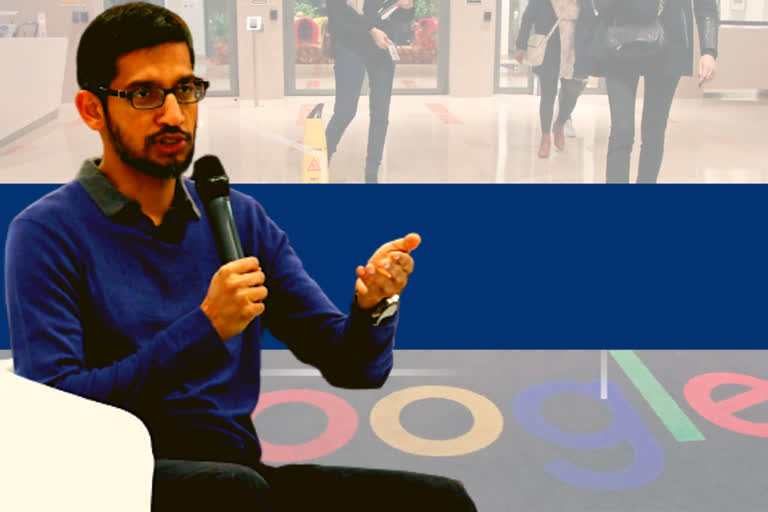New Delhi: Sixteen years ago when Google opened its first centre in the country in Hyderabad, the idea was to develop tools to help Indians find information about their favourite Bollywood stars and cricket. Since then the country has emerged one of the biggest innovation centres of internet giant which has fundamentally changed the way people interact with the internet in almost every sphere of human life.
Today, Google is almost everywhere. It commands over 86% of the internet search market leaving rivals like Yahoo, Alta Vista and others far behind, the company’s map application Google Map has become a necessity, it’s mail service Gmail has long overshadowed other mail services, including email pioneer Hotmail and other rivals like Yahoo Mail. Google-owned YouTube is the world’s largest video site, while Google’s mobile operating system Android commands three-fourth of the smartphone market.
Google, which was founded by Larry Page and Sergey Brin in September 1998, came to India within six years of its founding in California, USA.
Google’s Indian operation, which was focused on films and cricket, two biggest all-time passion in the country, is now at the forefront of the development of the cutting-edge technology for the rest of the world.
Indian-American Sundar Pichai, who is CEO of both Alphabet Inc, Google’s parent company and its subsidiary Google, Monday announced that the company will invest Rs 75,000 crores or nearly $10 billion in India in next 5-7 years to drive India’s digital economy and growth.
Within 16 years of opening its first office, the company has been developing and testing some of its most sophisticated technologies in the country, which will be used worldwide.
India leads the world in developing digital payment tech
In 2018, Google launched its payment wallet targeted at Indian users. It was known as Google Tez and was later renamed as Google Pay.
Sundar Pichai said India is setting the global standard on how to digitize payments, and it’s now helping us build a global product.
“A recent example is G-Pay, our fast, simple way to pay contactless or online. Together with the rise in BHIM-UPI adoption, GPay makes it easy to pay the rickshawala, or send money to family back home,” said Sundar Pichai.
Rapid adoption of tech by India’s small businesses
What has amazed Google is the rapid adoption of technology by the country’s small businesses that are driving these changes.
According to Sundar Pichai, just four years ago, only one-third of all small businesses in the country had an online presence. Today, 2.6 crores (26 million) small businesses in the country are discoverable on Search and Maps, linking more than 15 crores (150 million) users every month.
Sundar Pichai says one of the most exciting success stories has been the digitization of small businesses in the country.
“What’s more, small merchants across the country are now equipped to accept digital payments. This has made it possible for more small businesses to become part of the formal economy, and it improves their access to credit,” said the Google CEO.
Bolo (Reading App) developed in India for the world
India is the world’s biggest voice search market for the internet giant. Google is at the forefront of development and use of Artificial Intelligence. It also helped the company to adopt and modify the product specifically developed for India in the rest of the world.
Sundar Pichai says Google’s AI-powered reading tutor app Bolo (speak up), now called Read-Along, is another example of a technology built specifically for Indian users which was later adopted in rest of the world.
“It received such positive reception, we’re rolling it out to the rest of the world. Now children in 180 countries can learn to read in nine languages, with more to come,” Pichai said.
“These are just a few examples of how innovations that start in India can benefit the rest of the world,” he added.
What Google will do in India with $10 billion
Sundar Pichai said the company will invest this amount over the next 5-7 years in the country. “We’ll do this through a mix of equity investments, partnerships, and operational, infrastructure and ecosystem investments,” Pichai said. “This is a reflection of our confidence in the future of India and its digital economy,” added the Indian-American CEO.
He said this massive investment will be used in four focus areas, (a) enabling affordable access and information for every Indian in their own language (b) development of new products and services suitable to India’s unique needs, (c) helping Indian businesses in their digital transformation, and (d) using Artificial Intelligence in areas like health, education, and agriculture for social good.
“When I was young, every new piece of technology brought new opportunities to learn and grow. But I always had to wait for it to arrive from someplace else,” Pichai said while recalling his experience as a student when he had to wait for technology to come to India.
“Today, people in India no longer have to wait for technology to come to you. A whole new generation of technologies is happening in India first,” he said.
Also Read: Google to invest Rs 75,000 crore to boost digitisation in India



